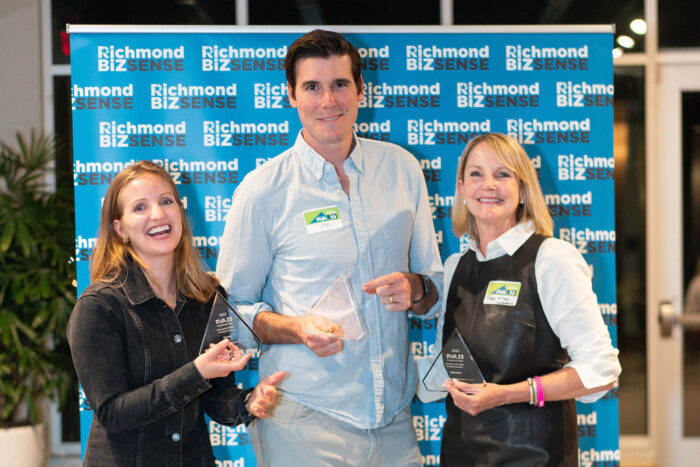With its revenue climbing at an average of 1,238 percent over the preceding three years, Brandefy had “no ceiling” when it topped last year’s RVA 25 list of fastest-growing local companies.
In the 12 months since then, with another $1 million in revenue from its cosmetic skincare line, Brandefy’s founder and CEO Meg Pryde still sees nothing but blue skies overhead for the six-year-old firm.
The difference now, Pryde said, really comes down to the ground beneath her.
That can be taken literally, considering she relocated the startup’s headquarters and warehouse this year from a combined location in Henrico back to its original Startup Virginia offices in Shockoe Bottom and to a much larger, 5,000-square-foot fulfillment center in Knoxville, Tennessee, respectively.
But that sentiment is also figurative, as it relates to the business’s stability.
Now settled into its new digs, which Pryde said are more appropriate for a stabilizing startup than its previous warehouse setup was, Brandefy has shifted its focus from raising capital to achieving profitability.
“In the fourth quarter of last year, rather than just looking at top-line growth, we reframed our focus far more on our bottom line,” Pryde explained when BizSense caught up with her before the release of this year’s edition of RVA 25. “We’re now so close to profitability. It’s been an exciting change in our trajectory.”
Profitability would be huge, she said, for a company that’s just three years into its model for generating revenue. While Pryde launched Brandefy six years ago from the very Startup Virginia offices that the team has now returned to, it wasn’t initially a sales platform.
After a stint in marketing, Pryde wanted to bring more transparency to consumer packaged goods prices, which she said tend to be based far more on brand names and fancy packaging than on ingredients and quality.
Pryde conceived Brandefy as a digital platform for crowd-sourced community reviews and price comparisons of household products. The focus on skincare happened by chance, she said, as it ended up being the segment that generated the most buzz.
Pryde brought her vision to market when she launched Brandefy’s website and mobile app in 2018, attracting more than $5 million in investor funding along the way.
But it was the company’s development of its own skincare products several years later – which it now sells directly to consumers on its website, app, and on Amazon – that jump started its current trajectory and landed it atop the RVA 25.
Brandefy’s sales increased with the addition of three new products this year, with the brand’s catalog now up to 10 unique formulations, and another “antioxidant glow serum” launching next month. Its most popular products include a retinol cream, an anti-aging serum, and a cleanser that was featured on an editorial segment of NBC’s “Today Show.”
That level of national publicity, which has been compounded by a lot of buzz on social media platforms like Instagram and TikTok, Pryde said, has helped generate enough demand that it’s been hard at times to keep up.
Brandefy has contracted manufacturers in Korea and the United States to produce and package its products, which are then sent to and shipped out from Brandefy’s fulfillment center. Though many of its customers are in Virginia, the move to Tennessee allows for a more geographically central location for shipping, Pryde said.
The Knoxville warehouse is “massive,” Pryde added, allowing for storage of up to around 400 pallets’ worth of packaged goods. With one of its most popular products, the Superfood Nourish Cleanser, currently sold out, she said that the additional space will allow the team to hold more inventory on hand to keep up with demand.
Despite the addition of its own line of products, Brandefy is still anchored by community-driven comparison and reviews, which Pryde said is one of the company’s differentiating factors in the skincare market.
“The reviews are still what our community really gets excited about,” she said.
Deciding which products to develop and produce is driven by Brandefy’s process of engaging with its clientele’s reviews to determine where there’s a gap in the market or where there’s a need for a less-expensive variant of a popular luxury product.
The six full-time employees that make up Brandfey’s team, which is mostly still based in Richmond, manually sift through the reviews and parse them through Brandefy’s framework.
Artificial intelligence is now also part of the mix, with the launch of an AI-driven ingredient comparison and explanation feature on Brandefy’s website and app. That saves time for the chemists who make up part of Brandefy’s repertoire of advisors in the science and medical professions, which also expanded this year with the addition of board-certified dermatologist Dr. Chris Tomassian.
“It’s not as obvious as it may seem, but the best recommendation any skincare product can get will always come from someone’s dermatologist,” Pryde said.
As such, Brandefy has started selling its products at some dermatologist offices, with that channel expanding by word-of-mouth through the network of the firm’s advisors.
But doctors’ offices are as far as Brandefy will go outside of its direct-to-consumer model, to which Pryde credits its ability to keep prices low.
“We will always be able to give the consumer a better value by selling it directly rather than through Sephora or Target or Ulta Beauty,” she said, adding she’d have to raise prices to account for a retailer’s cut, which could be as much as 50% or more in some cases.
Asked about price inflation in recent years, Pryde said that in some ways, it’s been a benefit to the business.
“Because our app lets consumers compare products and prices, people turn to us to help them find better deals. We did have to increase the price of three of our lower-priced products, but we always try to keep prices consistent and fair,” she said.
All of Brandefy’s skincare products currently sell from $29-$59. One of the brand’s top sellers, Pryde said, is a $49 vitamin C serum that is “inspired” by a luxury product, SkinCeuticals Silymarin CF, which is almost three times more expensive.
“So while our price points might still be expensive to some people, they are a huge value when compared to a similar product priced at $182, for instance.”
Applications are now open for this year’s RVA 25 rankings. Click here to learn more and apply. The deadline is this Friday, Sept. 20. The top 25 will be honored at an awards ceremony on Nov. 4.
With its revenue climbing at an average of 1,238 percent over the preceding three years, Brandefy had “no ceiling” when it topped last year’s RVA 25 list of fastest-growing local companies.
In the 12 months since then, with another $1 million in revenue from its cosmetic skincare line, Brandefy’s founder and CEO Meg Pryde still sees nothing but blue skies overhead for the six-year-old firm.
The difference now, Pryde said, really comes down to the ground beneath her.
That can be taken literally, considering she relocated the startup’s headquarters and warehouse this year from a combined location in Henrico back to its original Startup Virginia offices in Shockoe Bottom and to a much larger, 5,000-square-foot fulfillment center in Knoxville, Tennessee, respectively.
But that sentiment is also figurative, as it relates to the business’s stability.
Now settled into its new digs, which Pryde said are more appropriate for a stabilizing startup than its previous warehouse setup was, Brandefy has shifted its focus from raising capital to achieving profitability.
“In the fourth quarter of last year, rather than just looking at top-line growth, we reframed our focus far more on our bottom line,” Pryde explained when BizSense caught up with her before the release of this year’s edition of RVA 25. “We’re now so close to profitability. It’s been an exciting change in our trajectory.”
Profitability would be huge, she said, for a company that’s just three years into its model for generating revenue. While Pryde launched Brandefy six years ago from the very Startup Virginia offices that the team has now returned to, it wasn’t initially a sales platform.
After a stint in marketing, Pryde wanted to bring more transparency to consumer packaged goods prices, which she said tend to be based far more on brand names and fancy packaging than on ingredients and quality.
Pryde conceived Brandefy as a digital platform for crowd-sourced community reviews and price comparisons of household products. The focus on skincare happened by chance, she said, as it ended up being the segment that generated the most buzz.
Pryde brought her vision to market when she launched Brandefy’s website and mobile app in 2018, attracting more than $5 million in investor funding along the way.
But it was the company’s development of its own skincare products several years later – which it now sells directly to consumers on its website, app, and on Amazon – that jump started its current trajectory and landed it atop the RVA 25.
Brandefy’s sales increased with the addition of three new products this year, with the brand’s catalog now up to 10 unique formulations, and another “antioxidant glow serum” launching next month. Its most popular products include a retinol cream, an anti-aging serum, and a cleanser that was featured on an editorial segment of NBC’s “Today Show.”
That level of national publicity, which has been compounded by a lot of buzz on social media platforms like Instagram and TikTok, Pryde said, has helped generate enough demand that it’s been hard at times to keep up.
Brandefy has contracted manufacturers in Korea and the United States to produce and package its products, which are then sent to and shipped out from Brandefy’s fulfillment center. Though many of its customers are in Virginia, the move to Tennessee allows for a more geographically central location for shipping, Pryde said.
The Knoxville warehouse is “massive,” Pryde added, allowing for storage of up to around 400 pallets’ worth of packaged goods. With one of its most popular products, the Superfood Nourish Cleanser, currently sold out, she said that the additional space will allow the team to hold more inventory on hand to keep up with demand.
Despite the addition of its own line of products, Brandefy is still anchored by community-driven comparison and reviews, which Pryde said is one of the company’s differentiating factors in the skincare market.
“The reviews are still what our community really gets excited about,” she said.
Deciding which products to develop and produce is driven by Brandefy’s process of engaging with its clientele’s reviews to determine where there’s a gap in the market or where there’s a need for a less-expensive variant of a popular luxury product.
The six full-time employees that make up Brandfey’s team, which is mostly still based in Richmond, manually sift through the reviews and parse them through Brandefy’s framework.
Artificial intelligence is now also part of the mix, with the launch of an AI-driven ingredient comparison and explanation feature on Brandefy’s website and app. That saves time for the chemists who make up part of Brandefy’s repertoire of advisors in the science and medical professions, which also expanded this year with the addition of board-certified dermatologist Dr. Chris Tomassian.
“It’s not as obvious as it may seem, but the best recommendation any skincare product can get will always come from someone’s dermatologist,” Pryde said.
As such, Brandefy has started selling its products at some dermatologist offices, with that channel expanding by word-of-mouth through the network of the firm’s advisors.
But doctors’ offices are as far as Brandefy will go outside of its direct-to-consumer model, to which Pryde credits its ability to keep prices low.
“We will always be able to give the consumer a better value by selling it directly rather than through Sephora or Target or Ulta Beauty,” she said, adding she’d have to raise prices to account for a retailer’s cut, which could be as much as 50% or more in some cases.
Asked about price inflation in recent years, Pryde said that in some ways, it’s been a benefit to the business.
“Because our app lets consumers compare products and prices, people turn to us to help them find better deals. We did have to increase the price of three of our lower-priced products, but we always try to keep prices consistent and fair,” she said.
All of Brandefy’s skincare products currently sell from $29-$59. One of the brand’s top sellers, Pryde said, is a $49 vitamin C serum that is “inspired” by a luxury product, SkinCeuticals Silymarin CF, which is almost three times more expensive.
“So while our price points might still be expensive to some people, they are a huge value when compared to a similar product priced at $182, for instance.”
Applications are now open for this year’s RVA 25 rankings. Click here to learn more and apply. The deadline is this Friday, Sept. 20. The top 25 will be honored at an awards ceremony on Nov. 4.







Revenue is vanity. Profit is reality.
I think Ben Franklin posted that on the internet a few years ago.
“Pain is bad. Gain is good.”